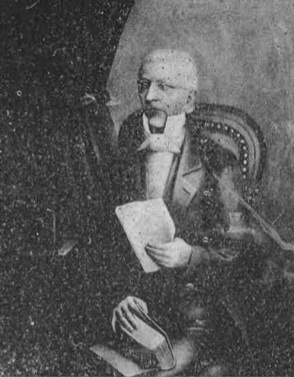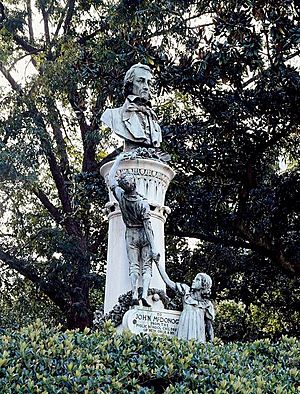John McDonogh facts for kids
Quick facts for kids
John McDonogh
|
|
|---|---|
 |
|
| Born | December 29, 1779 |
| Died | October 26, 1850 (aged 70) |
| Occupation | Trader, real estate speculator |
John McDonogh (born December 29, 1779 – died October 26, 1850) was an American businessman. He spent most of his adult life in Louisiana and Baltimore. He became very rich from buying and selling land and from shipping goods.
McDonogh owned enslaved people. He supported a group called the American Colonization Society. This group helped freed African Americans move to Liberia in Africa. McDonogh also created a special plan for the people he enslaved. They could "buy" their freedom over about 15 years.
In his will, McDonogh left a lot of money for public schools. This money was meant to educate children from poor white families and freed African American families. These schools were in New Orleans and Baltimore. By the 1970s, about 20 schools in New Orleans were named after him.
Contents
John McDonogh's Life and Work
John McDonogh was born in Baltimore, Maryland. He started working in the shipping business there. In 1800, his bosses sent him to Liverpool, England. His job was to get goods for trade in Louisiana. He did well, and after a second trip, he decided to live in New Orleans.
He opened a store and worked in shipping. He became very successful. By 1807, McDonogh stopped his store work. He started focusing on buying and selling land. He bought huge areas of land in Spanish West Florida.
In 1818, he tried to become a U.S. Senator. After he lost the election, he left New Orleans. He moved across the Mississippi River and started a town called McDonoghville. Today, this area is part of Algiers and Gretna. His home in McDonoghville has since been washed away by the river.
Some stories say McDonogh tried to marry Micaela Almonester. She became a very important person in New Orleans history. However, there is no proof of this. He also tried to marry someone else later in life but was turned down. Not getting married and losing the election might have made him live a quiet life. People knew him as a public figure, but he wasn't very popular. One newspaper said he was kind, even though most people thought he wasn't. Another said he was "rigid, severe and repelling."
McDonogh worked very hard, almost until he died. He managed his huge land holdings. In 1850, when he passed away, his land was thought to be the largest owned by any private person in the country. His land surrounded the growing city of New Orleans and other parts of Louisiana.
Slavery and Freedom for Enslaved People
John McDonogh owned enslaved people. In 1822, he created a plan for them to gain their freedom. This plan allowed his enslaved workers to "buy" their freedom. It took about 15 years for them to complete this process. This meant he benefited from their work before they became free.
McDonogh also helped the American Colonization Society. He gave money to this group. The Society helped freed Black people move back to Africa. McDonogh used the Society to help many of the people he had enslaved travel to Liberia.
David and Washington McDonogh
McDonogh saw two of the enslaved young men he owned, David K. McDonogh and Washington Watts McDonogh, as very promising. He wanted them to go to Liberia. To prepare them, McDonogh taught David and Washington to read and write. This was against the laws in Louisiana at the time.
McDonogh wanted them to become missionaries. So, he arranged for them to study at Lafayette College in Easton, Pennsylvania. They started in May 1838.
Washington found school difficult. He left the college in June 1842. He then moved to Liberia and lived there for the rest of his life. He was even elected to the country's legislature.
David did very well at Lafayette. He studied medicine and anatomy. He also worked with a local doctor. David graduated in September 1844. However, David did not want to go to Liberia. He moved to New York City instead. There, he was active in politics and medicine. David earned a medical degree in 1875. He died in Newark, New Jersey in 1893. In 1898, a hospital in New York City was named McDonough Memorial in David's honor. It was the first hospital in the city with both Black and white doctors and patients. The hospital closed in 1904.
John McDonogh's Lasting Impact

Even though some people thought McDonogh was very careful with his money, he left most of his wealth for a good cause. He had almost $2 million. He gave this money to the cities of Baltimore and New Orleans. The money was to build public schools for poor children. Specifically, it was for white children and freed Black children.
This was a very unusual gift and caused some arguments. His family challenged his will in court. The case, McDonogh's Executors v. Murdoch, went all the way to the U.S. Supreme Court. This delayed the will's plans until 1858. New Orleans eventually received about $704,440.
Baltimore already had a good public school system. But McDonogh's will also asked for a "school farm" for boys who needed help. This farm was to be built outside the city. McDonogh School in Owings Mills, Maryland, which opened in 1873, was created because of this.
The New Orleans public school system started in 1841. But McDonogh's money helped it grow a lot. Over 30 schools were built, many named "McDonogh" with a number. By the early 1970s, 20 McDonogh schools were still open in New Orleans. In the 1980s and 1990s, many of these schools were renamed. This was part of a movement to remove names of slaveholders from public schools. Some John McDonogh schools are still open today, including John McDonogh High School and McDonogh #7, #15, #26, #28, #32, #35, and #42.
Managing McDonogh's will was hard because he owned so many properties. Many of them were rented out. Also, McDonogh said the properties should be a permanent trust and never sold. The people in charge of the trust eventually got a court order to sell the properties. Money from the trust helped fund schools for about 100 years. However, as the population grew, the money was not enough to cover all school expenses.
Gravesite and Yearly Events
After John McDonogh died in 1850, he was buried with some of the people he had enslaved. This was at the McDonogh Cemetery (now McDonoghville Cemetery) on his land in Gretna, Louisiana. In 1860, his body was moved and re-buried in the Green Mount Cemetery in Baltimore.
In 1945, John McDonogh's body was moved again. This time, he was re-buried on the campus of McDonogh School in Owings Mills, Maryland. He rests there today, under a monument. This monument has his rules for living carved into it. The same monument was on his grave in Baltimore and was moved to the school in 1945.
McDonogh asked for one thing in return for his gift. He wanted children to plant and water flowers around his grave every year. Since 1875, students at McDonogh School have done this. They do it during the school's annual Founder's Day ceremony.
In New Orleans, the yearly ceremony became part of an important protest. This was the McDonogh Day Boycott of 1954. African American groups, including the NAACP, did not like that white children went first. They wanted both Black and white children to participate at the same time. When police said no, a boycott was organized.
McDonogh No. 26 School is the last school in the New Orleans area that still honors this tradition. In their yearly John McDonogh Day ceremony, students place flowers on a cenotaph. This is a monument honoring McDonogh at the site of his old tomb in McDonoghville Cemetery.
Other Monuments
In 1938, a statue of John McDonogh was put up in Uptown New Orleans. It was part of the Federal Art Project. The statue was made by Angela Gregory. In 1958, it was moved to Duncan Plaza near the new City Hall. On June 13, 2020, protestors pulled the statue down. They threw it into the Mississippi River. The next day, June 14, the statue was found in the river. It was then returned to city officials.

